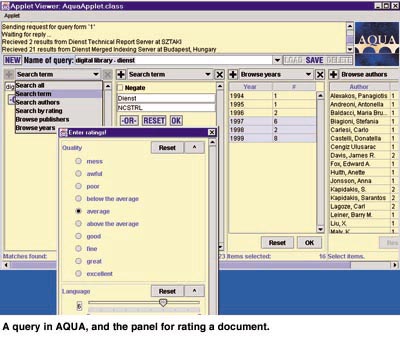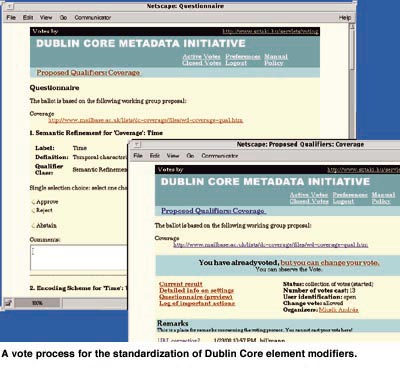

by László Kovács and András Micsik
The omnipotent presence of World Wide Web information sources and technologies made it feasible to build groupware applications using Web technologies. At the Department of Distributed Systems of SZTAKI, three projects are dealing with the development of collaborative Internet services integrating ideas from Computer Supported Cooperative Work: rating within a digital library, a collaborative information filtering project and an open voting Web service.
AQUA-2, User Interface for Rating within Digital Library
CommunitiesTechniques for querying digital library collections ranging from searching and browsing to relevance feedback, result ranking etc. are usually combined and users construct several queries until they get the desired results or the final query expression. A query interface that eases the building of the query expression is developed within the AQUA project (Advanced Query User Interface Architecture). The first version of AQUA was integrated with the Networked Computer Science Technical Reports Library (NCSTRL) using Dienst distributed digital library system.
The system builds upon the query chain paradigm: a sequence of alternate search and browse operations to filter the result sets of the preceding operations. Individual query or search operations are displayed via a GUI panel, the query chain is given by a series of panels. A great variety of query methods is offered. During an iterative query refinement, users build query chains that can be modified/refined at any point.
The AQUA framework and environment can ease future research as well as user experiments towards the development of advanced digital library query techniques and visualization methods.

AQUA is further developed towards a collaborative tool for digital library community use. AQUA-2 helps sharing knowledge and opinions about documents while AQUA (the first version) helped only sharing queries as well as exploration strategies among named or anonymous community members.
AQUA-2 supports digital document rating. Peer rating groups (reviewers) can be organized. They can attach their own ratings to documents they have visited. Associated ratings can help other users to find the most relevant (high-)quality documents. Ratings given by the users are collected in a SELECT server (SELECT is an EC funded project for social and collaborative filtering described below). The development of AQUA-2 is partly funded by KNIXMAS INCO project supported by EC.
SELECT, Social and Collaborative Filtering within WWW and Usenet News
Internet users need tools to find the information most valuable to them within the limited time they may have available. Information filters that make use of recommendations derived from individual users’ past choices and/or recommen-dations derived from the behavior of other users, especially those who have displayed similar tastes and interests in the past, are built within the SELECT project supported by EC Telematics Applications Programme.
Automatic methods where the system derives the filtering conditions from user actions or evaluations of documents using NLP (natural language processing) techniques are also being developed. Two different user interface techniques were developed: a bookmarklet-based thin SELECT client and a local proxy-based fat client. The thin SELECT client has the advantage of requiring virtually no installation and being accessible from any standard WWW browser. The proxy-based approach allows the content of a document (WWW page or Usenet News article) to be modified in different ways presenting the actual rating information of the document as well as other kinds of quality indicators. Thus, the SELECT architecture may be used as a gateway for the associated quality metainformation. The proxy-based client may also perceive/interpret the actual user behavior and translate it into implicit rating information.
The server consists of several modules for passive filtering (recommendations are based on the submitted ratings of documents), for active filtering (recommendations are based upon the ratings of documents submitted by people with interests and/or rating histories that match those of the user), a rating database containing ratings of registered and/or anonymous users, as well as a profile database containing information about users and their interests.
The prototype implementation of SELECT has recently been completed, user groups evaluations as well as the development of a new open SELECT framework for public testing of new collaborative filtering ideas and techniques are being initiated.
WWW-based Open Voting and Survey Service
The importance of computerized votes and related activities (polls, surveys, etc.) have been increasing since the globalization of the world’s information societies. Computer supported decision making processes can have beneficial effects on society; these tools may be able to open and clarify decision making processes, to help the evolution of people’s democratic attitudes.
A Reference Model for voting activities was defined as the first step. The voting process is split into the following subprocesses: initiation, collection, analysis, distribution, and decision making. A high-level vote control language was created for the definition of vote subprocesses.

A prototype voting and survey subsystem was developed at the Department of Distributed Systems of SZTAKI under the umbrella of Web4Groups of EC Telematics Application Programme. As a follow-up activity an Internet voting service was developed which has been operating as a public service of SZTAKI for more than one year allowing any user or closed group to create vote processes of any type.
Besides the basic functions of the service it has some features not found in other similar systems:
A version of the voting system is also used in a spin-off company of Kapsch AG., which promotes the Web4Groups WWW-based groupware application.
The public voting service at SZTAKI has many applications in various types of voting activities. It served as a public opinion collection tool in polls such as a questionnaire on user requirements by European R&D projects, a survey on the new graphical design of one of the WWW sites of the Hungarian government, surveys of a newspaper and a public library. It was used for decision polls within closed groups (selecting a logo for a digital community, a survey about a university lecture, deciding on the new name for a company, the approval of draft recommendations by the Dublin Core international standardization board, etc.). The system allows also to investigate the beneficial effect of multi-round votes in reaching the best consensus (two phase poll for the new state slogan for Victoria state (Australia) number plates).
Links:
AQUA project: http://www.sztaki.hu/sztaki/aszi/dsd/aqua
SELECT project: http://www.omega.it/research/select
SZTAKI vote service: http://www.sztaki.hu/services/voting
NCSTRL: http://www.ncstrl.org/
ETRDL (ERCIM Technical Reference Digital Library) user interface: http://www.sztaki.hu:8000/
Please contact:
László Kovács - SZTAKI
Tel: +36 1 209 5286
E-mail: laszlo.kovacs@sztaki.hu